QVD stands for QlikView data file. This type of file contains data stored using Qlik Sense or QlikView. QVD files can be created and read with Qlik Sense. But what's so special about these files?
QVD files have a format that makes it very fast to load when using the Sense script. When properly optimized, loading data from these files can be 10 to 100 times faster than any other source. QVD files are the core of any Qlik project. I have not seen any project not taking advantage of these files.
One QVD file will contain data from only one table. The table must be loaded into Qlik Sense before it can be stored in QVD format.
In a real-life project, you would usually pull data from a database or any other source and store it in QVD format. This allows you to be independent from the source the same moment you create the file and you also reduce the impact of hitting your source many times. When your source is a database in a live environment, the use of QVD files becomes the center of attention.
Using QVD files also allows you to bring data together from different sources. It is not uncommon that you work with different databases, spreadsheets, or online data. You can now create your data marts using QVD files.
Modifying these files is as easy as manipulating something in the script. Gone are the days where you had to wait for the slow IT department to make changes to the database so you can then show new things in your dashboards. With QVD files, you are in control and development time decreases drastically.
We mentioned in previous chapters that the best practice is to add as much as you can to your data source; however, we encourage you to leverage the power of building your own Qlik Sense infrastructure with your own QVD data sources. Not relying on others to get the job done is one of the key selling points of this tool. Own your project and data! Use Qlik Sense in the short term but always aim to have most of your calculations upstream.
Creating and maintaining your QVD files also has advantages. One of the most potent loading techniques consists of loading from your source only new or modified records instead of pulling, refreshing, or recreating your files from scratch. What's the point of loading millions of records every day if perhaps only thousands have been updated?
The first time you create the QVD will have to be, of course, a full extraction of your data source. However, once this first pull of data is done, the QVD file becomes your golden source. From here, you can pull only the modified or new records and append them to your existing QVD file. I will explain more of this in the following section.
